Face-Off: FIFA 16
Parity between PS4 and Xbox One - but is the Ignite Engine evolving fast enough?
Putting parity above all else, FIFA 16 arrives on PS4, Xbox One and PC with a near pixel-matched output on all three. It sticks to series tradition by keeping console-specific strengths limited to exclusive content, in the form of select cards in the Ultimate Team mode - where Xbox One gets a handful of legendary players this year. From a technical standpoint though, there's little to separate the console versions in terms of visuals or features - but as a package, does FIFA 16 bring anything tangibly different to the table over FIFA 15?
The setup is a familiar one for the series of course; everything is matched, from the full native 1920x1080 resolution to the lighting model, animation, and even grass shading and texture filtering levels. Thankfully, the per-object motion blur effect, which was missing from the Xbox One version of FIFA 15 at launch (and later patched in) is here from the start. The only discrepancy is during pre-match build-ups, involving long shots of stadia with high contrast edges. Here, PC delivers a slightly cleaner 1080p image owing to its use of 4x MSAA on these spots, not quite matched by the lower sample implementations on PS4 and Xbox One.
To get a good measure of how each stacks up though, we control both consoles in real-time from the exact same controller. As you can see in our video below, every sprint, pass and shot is performed via the exact same input, meaning we can match our footage as closely as possible. Outside of differing button prompts and an occasional offset in running animations, it goes a long way to prove there's a strong common ground between PS4 and Xbox One.
It's the same visual setup for each - and for PC too. Alas, the PC release once again arrives in something of a barebones form, shipping with a single toggle for low and high graphics detail (the latter matching the current-gen console standard). Besides this, we have a resolution option, plus a setting to lock the frame-rate at 30, 60fps or leave it entirely unlocked. All told, this is a fairly lightweight effort, and there's no question this is a console-first project, where PC extras are appended after the fact - and in this case it's the solitary inclusion of 4x MSAA.
Needless to say, if you've already bought FIFA 16 on PS4 or Xbox One, there's no need to check over your shoulder at the other version. The biggest difference between two is in Xbox One's exclusive set of players for Ultimate Team mode, offering classic players like Ryan Giggs and George Best in a card form. This is available on both Xbox 360 and Xbox One - a minor perk, and the only swaying point given that its visual quality and feature-set are so tightly paired with PS4 otherwise.
But exactly what does FIFA 16 add over the last game? Comparing gameplay directly with FIFA 15 via the same 'single controller' method, it's fair to say the upgrade isn't as stark as last year's. It's simply a refinement; the physically-based lighting is tweaked, and in one synchronised shot across Old Trafford it's apparent the pitch's tone is notably more saturated, with heavier bloom across players as well. A matching playthrough shows the underlying technology is very close to last year's though, and most of the changes elsewhere are in the pace of its gameplay.
The addition of women's teams tops the bill of new features in FIFA 16, where players from across 12 national squads are motion captured at EA's studios. For the majority of these additions, model quality matches the generally high quality of the men's game, and the use of repeated animations is just as apt to produce uncanny results. On the other hand, star players like Alex Morgan are given their own bespoke running and shooting animations - adding a distinctive flavour to their playing style.
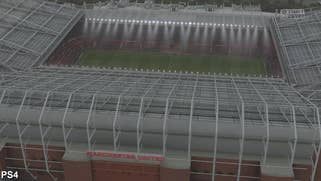
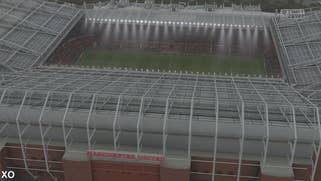
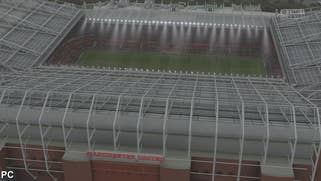



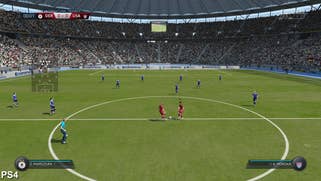

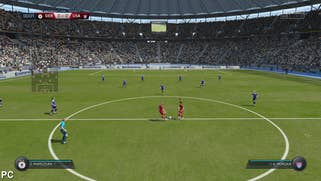



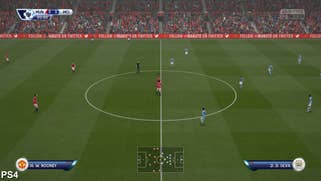
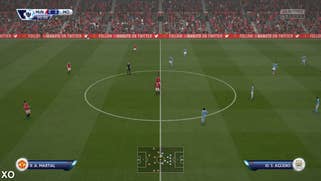


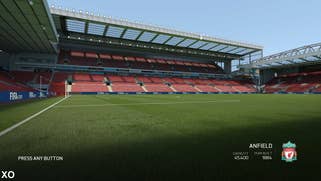

As for performance, if you've read our Face-Off features before, you'll be well aware of what to expect from FIFA 16. Essentially we keep a locked 60fps once a match kicks off, but with a hard switch to 30fps in certain engine-taxing scenarios. This only affects PS4 and Xbox One, where the 30fps cap is engaged during pre-match build-ups, replays, and also set-pieces such as penalties, free kicks and corners. However, as soon as we put a foot the ball, we go straight back to a perfectly smooth 60fps from the default side-line camera view.
The good news is, both PS4 and Xbox One keep a solid 60fps in place for the regular passing and shooting, provided it's always on this default camera. The drop down to 30fps doesn't really affect playability in this sense, and transitions between frame-rates only occurs in between cut-scenes and gameplay. On other words, it's not a jarring switch that can be spotted during play itself.
The only area where this 30fps cap is really felt is in the 'Be a Pro' camera mode. This lets us see the pitch from a player's orientation, and here the game locks to 30fps as we get a sideways view of the pitch, revealing all 22 players, referees and the crowds. It's a slight damper on the experience, and sweeping camera pans are noticeably less fluid than in regular view. On the plus side these scenes have a perfect lock on 30fps, and just as with 60fps play, we never see a frame dip below this number. As for PC players this isn't an issue at all, and every camera mode, replay and set-piece stays at 60fps if that's our intended setting in the menus.
FIFA 16: the Digital Foundry verdict
A running trend for the FIFA series this generation, a native 1080p resolution and 60fps gameplay continue to take a high priority on PS4 and Xbox One. The Ignite engine also gives identical results between the two once again, and PC only pips them to the post with its superior MSAA mode and non-compromised frame-rate. Otherwise, the lighting model, animation system, and even texture quality are exactly matched between all three platforms - right down to the filtering quality across the ground.
But as the third entry in the series this generation, it's fair to call FIFA 16 an incremental update in terms of its core engine capabilities. Tweaks to the ebb and flow of its passing makes this a slightly more defensive game by nature, and the addition of women's teams is a boon to the package overall. But the absence of true, overriding technical evolution is really felt this year; lighting tweaks are noticed over FIFA 15, but we hope Electronic Arts Canada is striving for a more substantive twist on the formula in next year's edition.
This feels like something of a stop-gap then, and one that we hope implies an incoming well-spring of new features next year. After all, these games are developed on a sharp, one year turnaround by a single studio, and to expect a revolution each time is perhaps too tall an order. Even so, the end result is still clear for FIFA 16; it doesn't take long to acclimatise to its look and play style, and technically there's a lot of commonality between this and last year's entry. It's déjà vu territory, but we're intrigued to see if FIFA can fit in another grand visual shift this generation, in line with Ignite engine's debut on PS4 and Xbox One two years ago.











